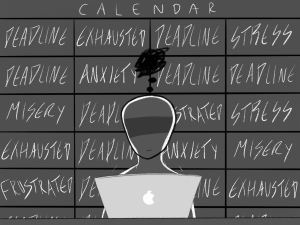School strikes shake American education
Courtesy VOA News
May 7, 2018
Rocking the American public education system, teachers in Oklahoma, Kentucky, West Virginia, and Arizona initiated walkouts throughout March and April to call for fairer teacher pay, better school conditions, and increased school funding. With thousands of educators marching nationwide, the strikes alerted lawmakers in these states, largely Republicans, to enact policies to rectify past tax and service cuts in public education.
Previous to the walkouts, a nationwide study by the National Education Association showed that Arizona, West Virginia and Oklahoma ranked 43rd, 48th, and 49th respectively in teacher salaries at $47,218, $45,622 and $45,276.
The issue of teacher salaries, regardless of current scrutiny in the Midwest, had also been examined at The Masters School. At the end of last year, a committee of administrators, with the approval of the financial committee and the Board of Trustees, in addition to research of the National Association for Independent Schools, created a new salary schedule for Masters’ teachers.
In response to its state government lowering teacher salaries to nearly $45,000, West Virginian educators began a walkout in early March for better benefits and higher pay, involving 22,000 teachers in 55 West Virginia school districts. After walking out for almost two weeks, the teachers’ efforts were rewarded as Governor James Justice signed a bill that not only raised teacher pay by 5%, to average around $48,000 a year.
In Oklahoma, teachers began to strike after their dissatisfaction with a bill that, despite providing teacher salary increases, only provided $50 million of the $200 million requested by educators in order to replace old textbooks and fund elective courses. In response, teachers marched to protest in Oklahoma City. After a nine-day walkout, they eventually returned to the classroom on Apr. 12 with raises of up to $6,000 raises. However, some of the teachers’ demands were not met. Janitors and cafeteria workers were promised a $5,000 increase in their salaries, but their raises were signed into law at only $1,250.
Kentucky’s walkout halted on Apr. 15 as the state government overrode Governor Matt Bevin’s veto, which reformed Kentucky’s tax code and opened up $22 million for state budget spending on public education.
In Arizona, Republican Governor Doug Ducey offered each teacher a 20% raise by 2020. In addition to the raise, Arizona’s teachers built a grassroots movement called “Red For Ed”, which entails them wearing red T-shirts while marching to the state capitol in Phoenix, rather than having a strike, according to LaborNotes.com, a non-profit organization for rank-and-file activists and union members.
These four states currently contain majorly Republican governorships and state legislative chambers that have passed substantial reductions in public education taxes and spending. As a result, the marches may have a negative impact on the Republicans’ success in the midterm elections. Despite many of the protesting teachers voting Republican according to their union officials, The President of The Oklahoma Education Association Alicia Priest relayed that in order for their demands to be fully met, teachers must vote for politicians who will make an effort to increase education spending, rather than politicians of their preferred political party.
Linking to Masters, the school’s new salary schedule uses a salary band to divide the faculty into those living on Masters’ campus and those living off campus. After that designation, faculty will be compensated based upon their teaching experience at the school.
“Our goal with the new salary schedule was to look at teachers’ experience at Masters and the number of years they have been at the school. In addition to adding the residential and non-residential components of salary, we looked at a variety of other school’s salary compositions and viewed how their teacher salaries were formatted. Based on that analysis, along with our own implementations into the salary band, we used a scale that uniquely fit that of Masters’ teachers,” Chief Financial Officer Ed Biddle said.
Biddle also made the distinction of how Masters’ faculty is paid upon their career teaching experience, rather than years of service in a specific state, which is the compensation system used by public school systems. Biddle further mentioned that some public school salaries are increased due to the number of Masters degrees that an educator may have, which he believes does indicate academic success, but doesn’t recognize classroom skills prior experience.
Dean of Faculty Erica Chapman feels that the schedule is a stable policy for the coming years, as faculty pay and benefits are represent 42% of Masters’ operating budget.
“The school’s goal for the new salary system was that it would be clear, equitable and transparent. I believe we have stayed true to those goals,” Chapman said.

























